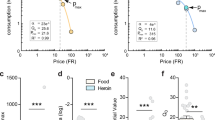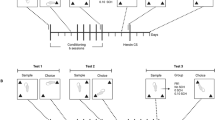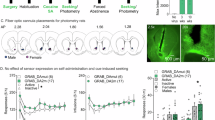Abstract
Caloric restriction during drug abstinence increases the risk for relapse in addicts. In rats, chronic food restriction during a period of withdrawal following heroin self-administration augments heroin seeking. The mechanisms underlying this effect are largely unknown. Here, we investigated the role of nucleus accumbens (NAc) shell and core dopamine (DA) in food restriction-induced augmentation of heroin seeking. Rats were trained to self-administer heroin (0.1 mg/kg/infusion) for 10 days. Next, rats were moved to the animal colony for a withdrawal period, during which rats were food restricted to 90% of their original body weight (FDR group) or given unrestricted access to food (sated group). On day 14 of food restriction, rats were returned to the operant conditioning chambers for a heroin-seeking test under extinction conditions. Extracellular DA levels were assessed using in vivo microdialysis. In separate experiments, the DA D1-like receptor antagonist SCH39166 (12.5, 25.0, or 50.0 ng/side) was administered into the NAc before the heroin-seeking test. In the NAc shell, pre-test exposure to the heroin-associated context increased DA only in FDR rats; but in the NAc core, DA increased regardless of feeding condition. Food restriction significantly augmented heroin seeking and increased DA in the NAc shell and core during the test. Intra-NAc shell administration of SCH39166 decreased heroin seeking in all rats. In contrast, in the NAc core, SCH39166 selectively decreased the augmentation of heroin-seeking induced by chronic food restriction. Taken together, these results suggest that activation of the DA D1-like receptor in the NAc core is important for food restriction-induced augmentation of heroin seeking.
Similar content being viewed by others
Log in or create a free account to read this content
Gain free access to this article, as well as selected content from this journal and more on nature.com
or
References
Bassareo V, Cucca F, Musio P, Lecca D, Frau R, Di Chiara G (2015). Nucleus accumbens shell and core dopamine responsiveness to sucrose in rats: role of response contingency and discriminative/conditioned cues. Eur J Neurosci 41: 802–809.
Bassareo V, Musio P, Di Chiara G (2011). Reciprocal responsiveness of nucleus accumbens shell and core dopamine to food- and drug-conditioned stimuli. Psychopharmacology (Berl) 214: 687–697.
Berridge KC (2007). The debate over dopamine’s role in reward: The case for incentive salience. Psychopharmacology 191: 391–431.
Berridge KC, Robinson TE (1998). What is the role of dopamine in reward: Hedonic impact, reward learning, or incentive salience? Brain Res Brain Res Rev 28: 309–369.
Bossert JM, Poles GC, Wihbey KA, Koya E, Shaham Y (2007). Differential effects of blockade of dopamine D1-family receptors in nucleus accumbens core or shell on reinstatement of heroin seeking induced by contextual and discrete cues. J Neurosci 27: 12655–12663.
Brown EE, Fibiger HC (1992). Cocaine-induced conditioned locomotion: absence of associated increases in dopamine release. Neuroscience 48: 621–629.
Carr KD, Tsimberg Y, Berman Y, Yamamoto N (2003). Evidence of increased dopamine receptor signaling in food-restricted rats. Neuroscience 119: 1157–1167.
Carr KD, Chau LS, Cabeza de Vaca S, Gustafson K, Stouffer M, Tukey DS et al (2010). AMPA receptor subunit GluR1 downstream of D-1 dopamine receptor stimulation in nucleus accumbens shell mediates increased drug reward magnitude in food-restricted rats. Neuroscience 165: 1074–1086.
Carroll ME, Meisch RA (1981). Determinants of increased drug self-administration due to food deprivation. Psychopharmacology 74: 197–200.
Carroll ME, Meisch RA (1984) Increased drug-reinforced behavior due to food deprivation. In: Thompson T, Dews PB, Barrett JE (eds). Advances in Behavioral Pharmacology. Academic Press: New York. pp 47–88.
Chaudhri N, Sahuque LL, Janak PH (2009). Ethanol seeking triggered by environmental context is attenuated by blocking dopamine D1 receptors in the nucleus accumbens core and shell in rats. Psychopharmacology (Berl) 207: 303–314.
Cheskin LJ, Hess JM, Henningfield J, Gorelick DA (2005). Calorie restriction increases cigarette use in adult smokers. Psychopharmacology 179: 430–436.
D’Cunha TM, Sedki F, Macri J, Casola C, Shalev U (2013). The effects of chronic food restriction on cue-induced heroin seeking in abstinent male rats. Psychopharmacology (Berl) 225: 241–250.
Duvauchelle CL, Ikegami A, Asami S, Robens J, Kressin K, Castaneda E (2000a). Effects of cocaine context on NAcc dopamine and behavioral activity after repeated intravenous cocaine administration. Brain Res 862: 49–58.
Duvauchelle CL, Ikegami A, Castaneda E (2000b). Conditioned increases in behavioral activity and accumbens dopamine levels produced by intravenous cocaine. Behav Neurosci 114: 1156–1166.
Fenu S, Spina L, Rivas E, Longoni R, Di Chiara G (2006). Morphine-conditioned single-trial place preference: role of nucleus accumbens shell dopamine receptors in acquisition, but not expression. Psychopharmacology (Berl) 187: 143–153.
Fuchs RA, Lasseter HC, Ramirez DR, Xie X (2008). Relapse to drug seeking following prolonged abstinence: the role of environmental stimuli. Drug Discov Today Dis Models 5: 251–258.
Gaiardi M, Bartoletti M, Bacchi A, Gubellini C, Babbini M (1987). Increased sensitivity to the stimulus properties of morphine in food deprived rats. Pharmacol Biochem Behav 26: 719–723.
Gao J, Li Y, Zhu N, Brimijoin S, Sui N (2013). Roles of dopaminergic innervation of nucleus accumbens shell and dorsolateral caudate-putamen in cue-induced morphine seeking after prolonged abstinence and the underlying D1- and D2-like receptor mechanisms in rats. J Psychopharmacol 27: 181–191.
Grimm JW, Hope BT, Wise RA, Shaham Y (2001). Incubation of cocaine craving after withdrawal. Nature 412: 141–142.
Hall SM, Tunstall CD, Vila KL, Duffy J (1992). Weight gain prevention and smoking cessation: cautionary findings. Am J Public Health 82: 799–803.
Ito R, Dalley JW, Howes SR, Robbins TW, Everitt BJ (2000). Dissociation in conditioned dopamine release in the nucleus accumbens core and shell in response to cocaine cues and during cocaine-seeking behavior in rats. J Neurosci 20: 7489–7495.
Jung C, Rabinowitsch A, Lee WT, Zheng D, de Vaca SC, Carr KD (2016). Effects of food restriction on expression of place conditioning and biochemical correlates in rat nucleus accumbens. Psychopharmacology (Berl) 233: 3161–3172.
Kalivas PW, Volkow ND (2005). The neural basis of addiction: a pathology of motivation and choice. Am J Psychiatry 162: 1403–1413.
Krahn D, Kurth C, Demitrack M, Drewnowski A (1992). The relationship of dieting severity and bulimic behaviors to alcohol and other drug use in young women. J Subst Abuse 4: 341–353.
Marchant NJ, Kaganovsky K (2015). A critical role of nucleus accumbens dopamine D1-family receptors in renewal of alcohol seeking after punishment-imposed abstinence. Behav Neurosci 129: 281–291.
Marchant NJ, Kaganovsky K, Shaham Y, Bossert JM (2015). Role of corticostriatal circuits in context-induced reinstatement of drug seeking. Brain Res 1628: 219–232.
Neisewander JL, O’Dell LE, Tran-Nguyen LT, Castaneda E, Fuchs RA (1996). Dopamine overflow in the nucleus accumbens during extinction and reinstatement of cocaine self administration behavior. Neuropsychopharmacology 15: 506–514.
Paxinos G, Watson C The rat brain in stereotaxic coordinates, 5th edn. Elsevier Academic Press: Burlington, 2005.
Pickens CL, Airavaara M, Theberge F, Fanous S, Hope BT, Shaham Y (2011). Neurobiology of the incubation of drug craving. Trends Neurosci 34: 411–420.
Sedki F, D’Cunha T, Shalev U (2013). A procedure to study the effect of prolonged food restriction on heroin seeking in abstinent rats. J Vis Exp e50751.
Shalev U, Grimm JW, Shaham Y (2002). Neurobiology of relapse to heroin and cocaine seeking: a review. Pharmacol Rev 54: 1–42.
Shalev U, Morales M, Hope BT, Yap J, Shaham Y (2001). Time dependent changes in extinction behavior and stress-induced reinstatement of drug seeking during heroin withdrawal. Psychopharmacology 156: 98–107.
Sorge RE, Rajabi H, Stewart J (2005). Rats maintained chronically on buprenorphine show reduced heroin and cocaine seeking in tests of extinction and drug-induced reinstatement. Neuropsychopharmacology 30: 1681–1692.
Stuber GD, Evans SB, Higgins MS, Pu Y, Figlewicz DP (2002). Food restriction modulates amphetamine-conditioned place preference and nucleus accumbens dopamine release in the rat. Synapse 46: 83–90.
Tobin S, Sedki F, Abbas Z, Shalev U (2013). Antagonism of the dopamine D1-like receptor in mesocorticolimbic nuclei attenuates acute food deprivation-induced reinstatement of heroin seeking in rats. Eur J Neurosci 37: 972–981.
Walter S, Kuschinsky K (1989). Conditioning of morphine-induced locomotor activity and stereotyped behaviour in rats. J Neural Transm Gen Sect 78: 231–247.
Wise RA, Leone P, Rivest R, Leeb K (1995). Elevations of nucleus accumbens dopamine and DOPAC levels during intravenous heroin self-administration. Synapse 21: 140–148.
Zacny JP, Lichtor JL, Zaragoza JG, de Wit H (1992). Effects of fasting on responses to intravenous fentanyl in healthy volunteers. J Subst Abuse 4: 197–207.
Acknowledgements
This work was supported by the Natural Sciences & Engineering Council (NSERC) Discovery Program (to US: 298915), the Fonds de recherche du Quebec - Santé (to CSBN), and the Canada Research Chairs program (to US). TMD and FS were funded by NSERC (PGS D and CGS D, respectively).
Author information
Authors and Affiliations
Corresponding author
Additional information
Supplementary Information accompanies the paper on the Neuropsychopharmacology website
Supplementary information
Rights and permissions
About this article
Cite this article
D'Cunha, T., Daoud, E., Rizzo, D. et al. Augmentation of Heroin Seeking Following Chronic Food Restriction in the Rat: Differential Role for Dopamine Transmission in the Nucleus Accumbens Shell and Core. Neuropsychopharmacol 42, 1136–1145 (2017). https://doi.org/10.1038/npp.2016.250
Received:
Revised:
Accepted:
Published:
Issue date:
DOI: https://doi.org/10.1038/npp.2016.250
This article is cited by
-
Metabolic and Addiction Indices in Patients on Opioid Agonist Medication-Assisted Treatment: A Comparison of Buprenorphine and Methadone
Scientific Reports (2020)
-
A role for leptin and ghrelin in the augmentation of heroin seeking induced by chronic food restriction
Psychopharmacology (2020)
-
Relapse to opioid seeking in rat models: behavior, pharmacology and circuits
Neuropsychopharmacology (2019)
-
Resistance exercise decreases heroin self-administration and alters gene expression in the nucleus accumbens of heroin-exposed rats
Psychopharmacology (2018)



